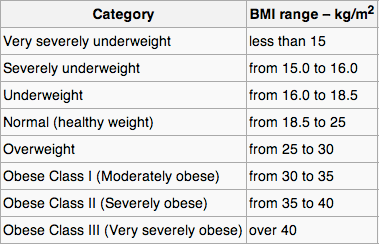
BMI, or Body Mass Index, has long been held as the standard for measuring our weight in relation to our height. The score we get tells us if we are underweight, normal weight, overweight, or obese.
Alternately, body composition is a different, more comprehensive way to understand the body -- not just whether you are "normal" or "overweight."
Let's take a look at these two measurements, and why body composition matters more if you're trying to be healthy.
What is BMI?
Your BMI is determined by dividing your weight by the square of your height. A BMI in the “normal” range falls between 18.5 and 25. That means that if you’re 5’10”, you’ll want to weigh about 130-175 pounds.

The problem with BMI is that the formula fails to account for many other important factors. With the simplicity of the calculation, BMI was never really designed to do more than tell us a range of normal weight for our height.
What is bigger, a pound of fat or a pound of muscle?
Muscle is significantly denser than fat, which mean that 10 pounds of muscle takes up much less space than 10 pounds of fat.
So what does this mean for the average person, who is looking to stay healthy? Well, if you’re simply just that, average – neither athletic nor overweight – then BMI can be a fairly good indicator of your current weight relative to your height. But if you are even a little bit athletic, or if you lead a fairly sedentary lifestyle, BMI can be misleading. Here is a simplified BMI scale as a reference:
- Underweight: Below 18.5
- Normal Weight: 18.5-25
- Overweight: 25-30
- Obese: Over 30
Athletic individuals generally have very low body fat percentages (5-10%). Clearly, athletes with BMIs over 25 are not overweight, they’re are in shape and athletically fit. Compare this to an individual who sits behind a desk everyday. This person may be aware of their weight and try to avoid gaining weight by trying to eat healthy, but does not exercise regularly. If this person is 5’6” and weighs 130 pounds they have a BMI score of 21. This score is in the normal BMI range.
Critics say BMI is too broad, its results are inaccurate, and it doesn’t really tell you anything about your body composition. For this reason, BMI has been coming under increased fire for its failure to give us a more detailed picture.
The History of BMI (and why it's flawed)
BMI was developed in the early- to mid-1800s by a Belgian scientist named Adolphe Quetelet. He envisioned a simple way to determine whether or not a person was overweight. For almost 200 years, it has remained the standard that medical professionals often turn to when researching obesity.
The World Health Organization still uses it as the standard for recording obesity statistics. It’s also used to examine trends. It works for getting the general feel for the overall health and well-being of a city or a nation, but BMI should never be used to assess health on an individual level. There are simply too many flaws in this evaluation.
One of the most famous examples of those flaws is Arnold Schwarzenegger. When he was in the prime of his bodybuilding career, he was 6’0” and weighed 235 pounds. This gave him a BMI of 31, putting him in the obese range. We know there are many words that can be used to describe his physique, but “obese” is definitely not one of them.
What is Body Composition?
We know that BMI provides an incomplete health and wellness picture. So, how do we get the full picture? Body composition. Body Composition is the amount of fat, Lean Body Mass, and water in your body. When you measure body leanness, you have to account for these factors; it can’t be just height and weight.
Essentially, body composition explains how much of your body is made up of:
- Fat
- Lean mass
- Water
- Everything else
If you’re interested in living a longer and healthier life, body fat percentage and lean muscle mass matter more than just your weight and BMI.
Body composition can be determined by bioelectrical impedance analysis, or BIA, which sends an electrical signal through your body. Based on how that signal interacts with the fat, muscle, and other elements of your body, the device is able to separate your weight into -- at a minimum -- Fat Mass and Lean Body Mass.
Our SECA device goes further and provides results for Skeletal Muscle Mass in each limb, Visceral Fat, and Body Water (intracellular and extracellular). It is time to start thinking of your weight in terms of what it is made up of (i.e. body composition).
Why Body Composition Analysis is Better than BMI
Tracking body fat percentage and lean muscle mass isn’t just about looking good: it’s about living longer and healthier. High body fat percentage increases the risk many illnesses, including diabetes and cardiovascular disease.
With a complete picture of your body composition, you’ll be able to determine if you have a high, medium, or low body fat percentage. If it is high, you will want to focus on decreasing your fat mass. If your body fat percentage is normal but your overall muscle mass is on the lower end, then working on building muscle strength and size is needed.
Although BMI has been used for a long time to assess weight, it’s time that we start tracking full body composition.
Body composition is not a fad, nor is it a trend in the health and wellness industry. Body fat percentage and Lean Body Mass have been well-studied and discussed in scientific literature for decades. Figure yours out, and you’ll be well on your way to a healthier, happier you.
Contact TransformYou today to learn more about body composition and our many options for healthy medical weight loss.
Read next in Medical Weight Loss

Metabolic Flexibility: What It Is & How to Train for It
By Dr. Robb Bird

Tirzepatide FAQ: Start Here
By Dr. Robb Bird

Improving Energy and Metabolism with Thyroid Hormone Therapy
By Dr. Robb Bird
Medically reviewed by Dr. Robb Bird, NMD FAARM
Medical Director, Transformyou

